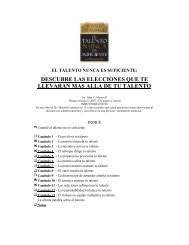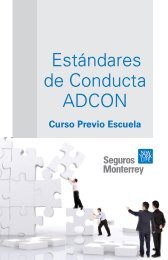SMARTPROS LTD. 2010 Annual Report to Shareholders
SMARTPROS LTD. 2010 Annual Report to Shareholders
SMARTPROS LTD. 2010 Annual Report to Shareholders
Create successful ePaper yourself
Turn your PDF publications into a flip-book with our unique Google optimized e-Paper software.
smartpros ltd and subsidiaries<br />
Management’s Discussion and Analysis of Financial Condition and Results of Operation<br />
Critical Accounting Policies and Estimates<br />
The discussion and analysis of our financial condition and results of operations is<br />
based on our consolidated financial statements that have been prepared according<br />
<strong>to</strong> accounting principles generally accepted in the United States. In preparing these<br />
financial statements, we are required <strong>to</strong> make estimates and judgments that affect<br />
the reported amounts of assets, liabilities, revenues and expenses and related<br />
disclosures of contingent assets and liabilities. We evaluate these estimates on<br />
an ongoing basis. We base these estimates on his<strong>to</strong>rical experience and on various<br />
other assumptions that we believe are reasonable under the circumstances, the<br />
results of which form the basis for making judgments about the carrying values of<br />
assets and liabilities. Actual results may differ from these estimates under different<br />
assumptions or conditions. We consider the following accounting policies <strong>to</strong> be the<br />
most important <strong>to</strong> the portrayal of our financial condition.<br />
Revenues<br />
A large portion of our revenues is in the form of subscription fees for any of our<br />
monthly accounting update programs or access <strong>to</strong> our library of accounting, financial<br />
services training and legal courses. Other sources of revenue include direct sales<br />
of programs or courses on a non-subscription basis or from various forms of live<br />
training, fees for Website design, software development, video production, course<br />
design and development, ongoing maintenance of the PEC, and licensing fees.<br />
Subscriptions are billed on an annual basis, payable in advance and deferred at the<br />
time of billing. Sales made over the Internet are by credit card only. Renewals are<br />
usually sent out 60 days before the subscription period ends. Larger transactions are<br />
usually dealt with by contract, the financial terms of which depend on the services<br />
being provided.<br />
Revenues from subscription services are recognized as earned; deferred at the time<br />
of billing or payment and amortized in<strong>to</strong> revenue on a monthly basis over the term of<br />
the subscription. Engineering products are non-subscription based and revenue is<br />
recognized upon shipment of the product or, in the case of online sales, payment.<br />
Revenues from live training are recognized when earned, usually upon the completion<br />
of the seminar or conference. Revenues from non-subscription services provided <strong>to</strong><br />
cus<strong>to</strong>mers, such as Website design, video production, consulting services and cus<strong>to</strong>m<br />
projects are generally recognized on a percentage of completion basis where<br />
sufficient information relating <strong>to</strong> project status and other supporting documentation<br />
is available. The contracts may have different billing arrangements resulting in either<br />
unbilled or deferred revenue. We obtain either a signed agreement or purchase order<br />
from our non-subscription cus<strong>to</strong>mers outlining the terms and conditions of the sale or<br />
service <strong>to</strong> be provided. Otherwise, these services are recognized as revenues after<br />
completion and delivery <strong>to</strong> the cus<strong>to</strong>mer. Duplication and related services are<br />
generally recognized upon shipment or, if later, when our obligations are complete<br />
and realization of receivable amounts is assured.<br />
Impairment of long-lived assets<br />
The Company evaluates the carrying value of goodwill and the recoverability of<br />
identifiable intangible assets and other long-lived tangible assets during the fourth<br />
quarter of each year and or whenever circumstances and situations change such<br />
that there is an indication that the carrying amounts may not be recovered or<br />
are impaired.<br />
Goodwill is evaluated by comparing the value of the reporting unit <strong>to</strong> the reporting<br />
unit’s carrying amount including goodwill. The fair value of the reporting unit is<br />
estimated using a combination of discounted cash flows approach and the market<br />
approach, which utilizes comparable company’s data. If the carrying amount of a<br />
reporting unit exceeds its fair value, then the amount of impairment loss must be<br />
measured. The impairment would be calculated by comparing the implied fair value<br />
of the reporting unit goodwill <strong>to</strong> its carrying amount. Any impairment loss would be<br />
recognized when the carrying amount of goodwill exceeds its implied fair value.<br />
The evaluation of the recoverability of identifiable intangible assets is measured by<br />
comparing the carrying amount of the asset against estimated undiscounted cash<br />
flows associated with it. Impairment may be caused by a number of fac<strong>to</strong>rs, including<br />
a significant decrease in the market value of an asset or a significant adverse change<br />
in the manner in which the asset is being used. The evaluation of asset impairment<br />
requires the Company <strong>to</strong> make assumptions about future cash flows over the life of<br />
the asset being evaluated. These assumptions require significant judgment and<br />
actual results may differ from assumed and estimated amounts.<br />
Upon completing our review and testing for the current period we believe that<br />
we have not incurred any impairment <strong>to</strong> such assets.<br />
S<strong>to</strong>ck-based compensation<br />
Compensation costs are recognized in the financial statements for s<strong>to</strong>ck options<br />
or grants awarded <strong>to</strong> employees and direc<strong>to</strong>rs. Options and warrants granted <strong>to</strong><br />
non-employees are recorded as an expense at the date of grant based on the then<br />
estimated fair value of the security granted.<br />
Segment reporting<br />
All of our operations constitute a single segment, that of educational services.<br />
Revenues from non-educational services, such as video production are not a material<br />
part of our operating income.<br />
Income taxes<br />
We account for deferred tax assets available principally from our fixed and intangible<br />
assets and our net operating loss carryforwards in accordance with the Accounting<br />
Standards Codification. We make significant estimates and assumptions in<br />
calculating our current period income tax liability and deferred tax assets. The most<br />
significant of these are estimates regarding future period earnings. Our net deferred<br />
tax asset is estimated by management using a five-year taxable income projection.<br />
p a g e 7






